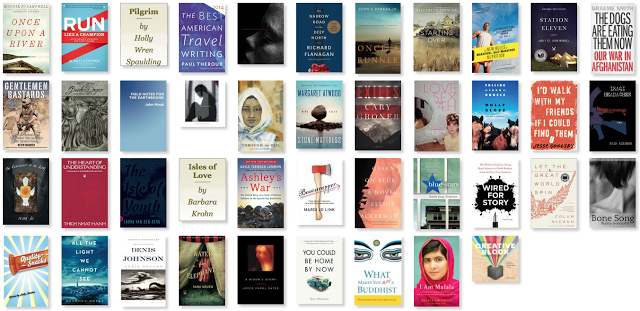 |
| My Goodreads shelf for 2015. |
I read about 40 books per year, plus at least 12 unpublished manuscripts for critiques or blurbs annually, which means—by December 31st—I’m typically pretty close to reaching my goal of one book per week. Here’s what stands out to me from 2015, and why:
This year, the most notable books of poetry I read were Bunny Goodjohn’s
Bone Song and Abby E. Murray’s
Quick Draw. I even informally interviewed Bunny about her book,
here.
The book I read this year with one of the tightest narrative forms and structures I’ve seen in years was Tracy Manaster’s surprising
You Could Be Home By Now. Although in the end, I didn’t feel as personally
invested in the characters’ lives as I had hoped, I continued to marvel at this author’s craft on the page: managing multiple narrative threads, multiple points of view (and overlapping them in scene, at times), and seamlessly offering backstory and characterizing details at just the right times. Bonus:this book is funny!
The book I re-read this year…and take note, because I’ve only re-read about 10 books that I’ve loved in the past 10 years…is
Bonnie Jo Campbell’s Once Upon a River. I re-read this for several reasons, the first being that when I read it in 2012, I was at a point of high skepticism in my approach to studying the work of others. I didn’t feel I had accepted the book on its own terms and wanted to read it again when I knew I had grown a little more as a writer and as a reader. Second, I read it to try to make sense of how the author, Bonnie Jo Campbell, keenly characterizes her protagonist Margo’s character in ways that allow her to
justify her actions. Some of what Margo does might be seen as a “hard sell,” yet Campbell persuades readers again and again. I wanted to study how she pulled it off.
The book I read this year that was a true delight—in terms of craft, entertainment, structure, and story—was
Mardi Jo Link’s Bootstrapper. While most folks will gloss over chapter titles and subtitles, a close reader will appreciate the many layers these small tools lend to Link’s book, which is a quick read but a deep plunge. I can’t wait to explore Link’s latest,
The Drummond Girls next.
Last but absolutely not least, the most surprising book I read in 2015 was
Denis Johnson’s Train Dreams. Maybe it’s because I’m from out West. Maybe it’s because I miss the landscape that made me. Maybe it’s because I’m a sucker for the ways in which landscape can shape character and reveal plot. Whatever the reasons, this book felt like being wrapped in warm blanket and being told my own, heartbreaking, creation myth. I loved every second, and cried throughout. I recommend this both in print and via Audible, as readers will find it moves along quickly—just a few hours, and this novella is done, but when you get up
from the chair, you’ll be startled to find yourself in the present. This book transported me more fully than any other I’ve read in a long time.
There’s so much more to be said about this list—John Mauk’s Field Notes for the Earthbound
or Holly Wren Spaulding’s Pilgrim, for instance, will make great gifts for the rockstar-quiet-mysterious-complex guy on your holiday list, and the Zen-nature-poetry-loving-minimalist on your holiday list, respectively. Graeme Smith’s The Dogs are Eating Them Now should be required reading for anyone with a vested interest in true war reportage and the hard lessons learned in the Middle East. And hands down, Creative Block, which I’m still finishing, is one of the best art/teaching books I’ve ever encountered.


